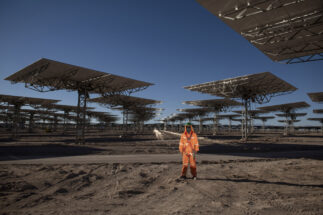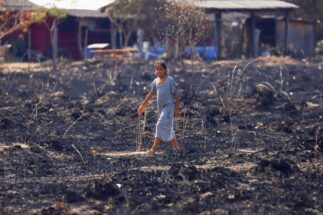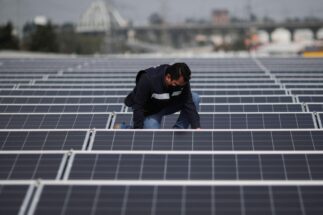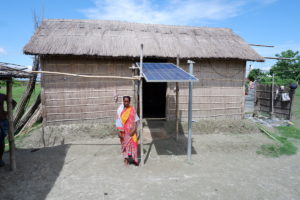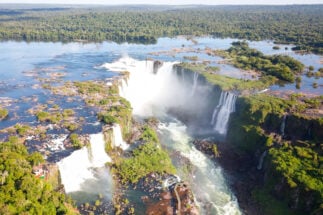Latin America and the Caribbean are not among the world’s major polluters, accounting for less than 10% of global greenhouse gas emissions, but the region must align with global emission reduction targets to avoid the worst consequences of global warming, a new report has warned.
On Monday, the Intergovernmental Panel on Climate Change (IPCC), the United Nations body that brings together the world’s leading climate scientists, released its synthesis report, a summary of its sixth round of assessments of the global climate, which highlighted how the impacts of climate change are more severe than previously thought.
As its last input prior to the “global stocktake” process that countries will undertake at this December’s COP28 summit, and the final release of the cycle, it made an urgent scientific call to meet the goal of limiting global warming to 1.5C above pre-industrial levels set by the Paris Agreement.
“Mainstreaming effective and equitable climate action will not only reduce losses and damages for nature and people, but will also deliver wider benefits,” said IPCC chair Hoesung Lee upon the report’s release. “This report underscores the urgency of taking more ambitious action and shows that, if we act now, we can still secure a liveable sustainable future for all.”

The synthesis provides a summary of the IPCC’s outputs since its fifth assessment cycle concluded in 2014: The Physical Science Basis; Impacts, Adaptation and Vulnerability; Mitigation of Climate Change; and three special reports: Global Warming of 1.5°C; Climate Change and Land; and Ocean and Cryosphere in a Changing Climate.
“This report provides all the scientific knowledge available so that we can make our last effort,” said Paulina Aldunce, a Chilean scientist and one of the report’s 39 authors.
To reach the Paris Agreement target, the IPCC states, there must be a 43% reduction in greenhouse gas emissions by 2030, compared to 2019 levels. From then on, the reduction must be progressive until reaching “net zero” in 2050. This decade is therefore key in determining whether warming can be limited to 1.5C, 2C or even higher. “The choices and actions implemented in this decade will have impacts now and for thousands of years,” the report’s Summary for Policymakers reads.
Human activities have so far led to global warming of 1.1C above pre-industrial levels, and the greenhouse gas emissions that drive this continue to rise. Projected emissions from the world’s existing fossil fuel infrastructure already exceed the so-called “carbon budget” to meet the 1.5C target. In other words, if fossil fuels are burned in existing power plants, reaching the Paris target will not be possible.
That is why UN Secretary-General António Guterres was – once again – clear in his reaction to the report: he called for no new coal plants to be permitted, and for an end all public and private financing for coal; for any expansion of existing oil and gas reserves to be stopped; and for a global phase-down of current oil and gas production compatible with net zero by 2050. “Our world needs climate action on all fronts – everything, everywhere, all at once,” he said.

Energy transition in Latin America
As the world faces the urgent need for a transition to clean energy, the IPCC’s report warns of a need to mitigate the risk to sustainable development in regions with a high dependency on fossil fuels for income and jobs – a situation true of many countries in Latin America. This balancing act “requires policies that promote economic and energy sector diversification and considerations of just transitions principles, processes and practices,” the report adds.
According to María Inés Rivadeneira, policy officer at WWF Latin America and the Caribbean, the region must also think about transitioning its development model. “It is not only about the energy model, because we have a very high dependence on people who work directly or indirectly in these sectors,” she told Diálogo Chino. “So, it’s not just about turning off the lights and changing business practices. We have to think about how this means a diversification of jobs, a transformation of infrastructure.”
The region, thus far, is not fulfilling the IPCC report’s call to action on phasing out fossil fuels. According to the Inter-American Development Bank (IDB), existing fossil fuel infrastructure expansion plans in Latin America are not compatible with the goals of the Paris Agreement.
Natural gas is considered by many governments in the region to be “transition fuel” from coal and oil, with a pipeline underway in Argentina and expansion plans in Mexico, for example. However, a UN report found that renewable energy could bring more economic, environmental and employment benefits to Latin America than plans to develop natural gas infrastructure.
Environmentalists have cast doubt on the region’s gas ambitions, and what they could mean for climate action – and realities – in the region. “While the IPCC report outlines what humanity must do to solve the climate crisis, the governments, companies and banks involved in projects like Vaca Muerta [an oil and gas field in Argentina] demonstrate the boundless greed that has brought us to this emergency situation,” Ilan Zugman, Latin America regional director for the NGO 350.org, told Diálogo Chino.
“We cannot push developing countries to do the dirty work that rich countries no longer want – the energy transition has to be global,” he added.
In its earlier report on mitigation, published in 2022, the IPCC called on Latin American countries to take advantage of falling renewable energy prices and “shape a sustainable trajectory that is more resilient and fit for the future”.
The region has almost everything it needs to make a transition to renewables, from ambitious targets to huge solar and wind potential, to growing local industries that could generate jobs – as many as 15 million across the region by 2030, the IDB reports. However, financing for the transition is still insufficient, with barriers to overcome to reverse this.

At the COP27 climate summit in 2022, Latin American governments called for increased funding for climate action, and less in the form of loans. According to a recent report, 81% of public climate finance for the region arrives as loans that only serve to increase governments’ already problematic debt levels.
Latin America can become a world benchmark for a just energy transition if future projects respect ecological balances and bring not only economic, but also social benefits
As a major investor, creditor and trading partner in the region, China is exploring new ways to contribute to climate action in Latin America, said Sisi Tang, a trade specialist at the International Institute for Sustainable Development. To this end, she suggested that China introduce a new financing scheme for renewable energy projects in the region and develop debt-for-nature swap schemes to incentivise protection and restoration of the environment.
According to a recent report published by Global Energy Monitor, Latin America has the potential to increase its solar and wind power capacity by more than 460% by 2030, which would put the region on track to meet, and potentially exceed, the International Energy Agency’s (IEA) regional renewable energy targets for 2030.
The document points to Brazil, Chile and Colombia as the countries with the largest renewable plans for the future. “Latin America can become a world benchmark for a just energy transition if future projects respect ecological balances and bring not only economic, but also social benefits,” said researcher Sophia Bauer at the report’s launch.
The scale of the challenge, however, remains significant. Though its share of energy from renewables, some 33% of supply, is higher than the global total of 12%, Latin America faces a tall task maintaining this figure – largely driven by hydropower, increasingly at risk in a changing climate – and reducing its dependence on fossil fuels, from which it derives the remaining two-thirds of its energy. As Guterres said at the IPCC report’s launch, it may take “a quantum leap in climate action” to confront this, to meet the targets of the Paris Agreement and avoid the worst effects of the climate crisis.
